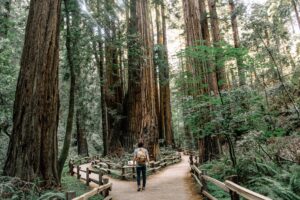 I discovered this image on Unsplash recently, and for some reason it really struck me. It’s beautiful, yes; it also evokes Robert Frost’s “The Road Not Taken,” the literal picture of a traveler stopped in the wood and trying to decide which way to turn. The hiker in the above photo hesitates, his foot not quite raised, considering his next step. Which way should he turn? Could his decision, as Frost pens, make “all the difference?”
I discovered this image on Unsplash recently, and for some reason it really struck me. It’s beautiful, yes; it also evokes Robert Frost’s “The Road Not Taken,” the literal picture of a traveler stopped in the wood and trying to decide which way to turn. The hiker in the above photo hesitates, his foot not quite raised, considering his next step. Which way should he turn? Could his decision, as Frost pens, make “all the difference?”
But take a minute and look at this picture again. There is a stark difference between this image and the scene laid out in Frost’s poem. Do you notice anything about the curve of the two paths?
From our perspective, we can guess that they’re going to come together again almost immediately!
Which means this huge decision really isn’t significant at all. But if the hiker hasn’t been paying attention as he approaches the fork in the trail, he might not know that. He might only see the massive tree before him. When you’re close enough to a problem, when you’re in the weeds of a decision (to mix some plant-based metaphors), everything can seem like it has massive consequences. You can’t see past the giant tree trunk blocking your vision. Everything seems like a big deal. In an abundance of caution, we can dwell on what we think is an important decision for hours, days, weeks — only to find that the decision really didn’t matter in the first place!
Leaders are faced with tough decisions daily; if we proceed too carefully, we’ll never get anything done! Now, don’t get me wrong; there is a place for caution, and when we make important decisions, we need it. Sometimes. But we must also be cautious of caution itself. Roosevelt said “there is nothing to fear but fear itself,” and I think caution works the same. We cannot allow it to cripple us.
Moving forward is the important thing; sometimes you just need to go with your gut and take that first step.
